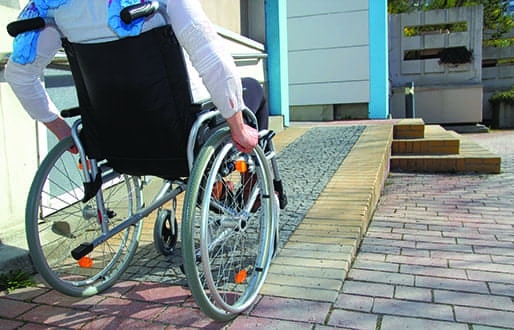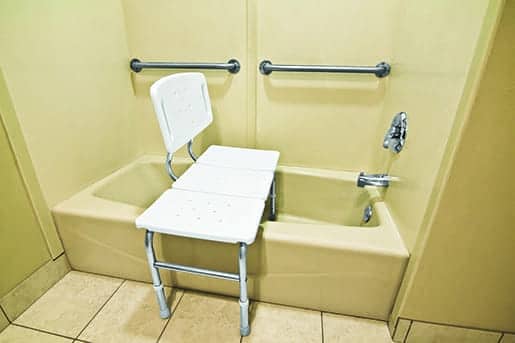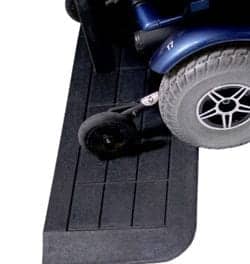
Entry and exit are long-term concerns that home modification strategies oftentimes address. A variety of solutions exist, with costs contingent on material selection and other factors.
by Scott A. Trudeau, PhD, OTR/L
Data from AARP in 2014 suggests that 87% of individuals older than age 65 years report a desire to remain in their present home and community. Couple this with the expanding demographics of individuals older than age 80 years and longer life expectancies, and it should not be a surprise that the marketplace for supporting older adults to age in place has also expanded in recent years. While the demand may be there, the best way to meet the needs of these individuals is less clear.
In spite of a vast array of evidence to support the importance of integrating universal design principles into new construction to support community participation across the lifespan, this is the exception rather than the rule. A parent pushing a baby stroller and an older adult using a rolling walker may benefit equally from ramps and flush thresholds. Since these features are not consistently (universally) built into most construction, we are faced with the need to come in later and retrofit homes to meet the functional needs of the residents.
Why Rehab?
Rehabilitation professionals have long recognized the powerful interplay of the individual and the environment necessary to optimize function and performance. Yet as our practices have become more medicalized and productivity driven, our ability to reach out into the community and evaluate the individual in context have become more limited. Now that rehabilitation processes are more fully embedded in medical models of care for older adults, the priorities for reimbursement are shifting. Driven by changes in CMS, our systems of care are increasingly value based, which shifts the focus toward the holistic factors that contribute to health outcomes. This new perspective appreciates that health and well-being are significantly more complex than just a reflection of medical status.
To truly provide value-based care, providers must look beyond the facility into the community. It is here at the intersection of healthcare and community that rehabilitation professions such as occupational and physical therapy can step in and add value. This is especially true when older adults are in need of assistance and support to successfully age in place. Successful aging in place allows an individual to continue to access valued and meaningful activity participation and opportunities for social connectedness. This will likely require considering not only performance within the home, but issues of access and mobility/transportation in the broader community.
A major concern that comes up when meeting the needs for aging in place is the potential for financial exploitation of older adults in the home remodeling process. As experts in function and environmental fit, rehabilitation professionals can direct adaptations to the environment that are both cost-effective and individualized to the specific needs of the occupants. Many of us have likely had a conversation with a client where they explain that although they had invested a great deal of money installing a “handicapped” bathroom, the space remains inaccessible to them. Or, the bathroom modifications may have been helpful initially, but after a few months they no longer meet their needs.
This raises another important feature related to our ability as health professionals to prognosticate and anticipate the potential for future needs based on the constellation of chronic and acute conditions of that particular individual. While we have come to attribute this process to client-centered care, it is critical that we fully appreciate that this provides a distinct value to those with whom we work. I would argue that this perspective is deeply rooted in our philosophies of care as rehabilitation professionals, so deep that we must be careful not to overlook its powerful contribution.
Opportunities for Modifications
As with most of our interventions, individual needs can be addressed with a range of strategies that each have to be considered within the context of that situation.
Key considerations:
1) Medical complexity and prognosis: are the functional limitations short or long term? Is further decline likely?
2) Client readiness and acceptance: reluctance to accept any changes that make the environment highlight a disability may limit options.
3) Physical space and maintenance of home environment: load-bearing walls and level of disrepair may limit flexibility.
4) Availability of resources to implement changes, both financial and social supports.
5) Appreciate the valued roles and activity routines that the individual needs to access in order live a meaningful existence.
Lower-Cost Options
In the schema of home modifications, the introduction of practical adaptations to compensate for challenges encountered should always be considered first. In one recent case a client was having some visual and depth perception challenges that were increasing his risk for falls. Complicating matters was the blending of the gray and brown tones transitioning from slate to brick to dark stained wood, which made it increasingly difficult for him to navigate these steps.
By simply removing the throw rug and adding some contrasting (in this case, white) 2-inch tape to each step, he was better able to differentiate each transition. The actual modification probably cost less than $1, but was highly effective. This relatively simple alteration was guided by the problem-solving and clinical reasoning of an occupational therapist. In contrast, a contractor may have offered a solution that included installation of ramps, railings, and potentially even widening the doorway—at far greater expense than necessary.
Another opportunity to intervene may include the provision of durable medical equipment (DME) and other adaptive equipment that could be considered low-cost alternatives to supporting aging in place. If an individual is having difficulty independently and safely transferring into the bathtub to take a shower, are they better served by a $125 transfer bench or a $15,000 roll-in shower? Admittedly, the answer to this question has to be individualized to the situation, but in many, if not most, the transfer bench can be adequate to meeting the needs for independence and safety with shower transfers.
One bathroom revision recently completed for a client with low vision and depth perception considered that the client’s balance and stability were quite good, but at times he had difficulty judging the clearance of the tub. We installed grab bars, a handheld shower head, and a rubber tub mat to make the process safer and easier for him. The installation of grab bars and the shower head required a bit of skill, but nowhere near the cost and disruption of a full bathroom remodel.

Shower interiors often are areas where simple revisions can improve safety and access. Grab bars and a transfer bench, for example, can provide substantial benefits for significantly less than the cost of a remodel.
Higher-Cost Options
Anyone considering a renovation or update of existing spaces should always consider integrating principles of universal design into their plans, especially if they are anticipating a desire to age in place. Incorporating increased spaces and wider door frames are relatively easy when a major renovation is being planned, but far more costly if these modifications are required as part of a retrofit process.
In relatively rare instances, individuals may benefit from more major (ramps, stairglides, lifts, etc) and costly alterations to the home to make aging in place an option. Cost considerations must compare expenses of home modification versus institutional support. Additionally, the availability of resources to support needed modifications should be considered, since typically justifying the medical necessity of home modifications is difficult within the Medicare/Medicaid reimbursements systems.
Ramps: The Americans with Disabilities Act sets the standard that ramps require one linear foot of ramp for each inch of incline. Thus, a typical 30-inch entry requires a 30-foot ramp. This slope requirement may challenge the feasibility of installing a fixed ramp. Fixed or permanent ramps can be fabricated from wood ($108 per l.f.), concrete ($200 per l.f.), metal ($264 to $2,090), or other materials.1 Costs are contingent on material selection and other factors.1
Portable ramps can include folding ramps ($100 to $1,048), which are generally made of aluminum and have different weight specifications.1 Roll-up ramps ($280 to $1,300) are similar to folding ramps, but can be rolled up for storage and are lightweight and compact.1 Track ramps ($240 to $1,900) are also made of lightweight aluminum and have two individual tracks that align with the wheels on both sides of a wheelchair and can be folded or opened to achieve the desired length.1 Track ramps can be more challenging for a caregiver to maneuver.
Lifts: Available space or physical limitations of the caregivers might make a wheelchair or platform lift, or elevator, preferable to a ramp. A traditional stair lift may be an option as well—especially for folks not confined to a wheelchair. Stair lifts are generally less expensive than platform lifts costing between $1,000 and $3,000.1
Though they may require a substantial budget, there are additional technologies that can be useful for individuals affected by an age-related disability or progressive neurodegenerative condition, such as multiple sclerosis. These technologies include ceiling-mounted lifts, wall-mounted lifts, or even portable lifts that can be used to transport an individual from room to room within the home. Also, for individuals who regularly use power or manual mobility devices, automated door opening systems that can be operated remotely from a control mounted on a wheelchair or by a wall-mounted push pad may offer a solution for entry, exit, and access throughout the home.
Technology
Are smart homes paving the way for the future of aging in place? Although not the primary focus of this article, it is worth mentioning that as technology advances, additional alternatives and options can be considered. Cost factors may be reduced as more technologies become mainstream and more widely available.
Conclusions
Traditional health care and reimbursement schema may not readily recognize the role of rehabilitative professionals in contributing to the well-being of community-dwelling older adults committed to aging in place. It is critical that occupational and physical therapists clearly articulate the added value of including the rehabilitative perspectives into plans and modifications to support aging in place. These perspectives are necessary to both optimize function and participation within the environment, and to provide individualized and cost-effective strategies to older adults. RM
Scott A. Trudeau, PhD, OTR/L, is the Productive Aging and Interprofessional Collaborative Practice Program Manager for the American Occupational Therapy Association. For more information, contact [email protected].
Reference
1. Paying for Senior Care. Retrieved from https://www.payingforseniorcare.com. Accessed November 2, 2017.




